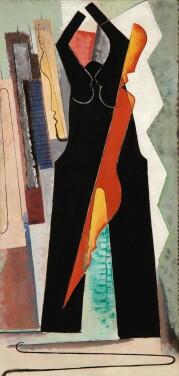Works by Man Ray at Sotheby's
Man Ray Biography
Born to Russian-Jewish immigrant parents and raised in Brooklyn, Man Ray (1890–1976) is best known for his striking photographs of the interwar period, which deliberately juxtaposed various elements to generate thought-provoking meaning. A painter, filmmaker, sculptor, and poet as well, the artist was also a commercial photographer for Vogue and Vanity Fair.
After showing artistic talent in high school, Ray devoted himself to painting. He was exposed to avant-garde art thanks to the legendary 1913 Amory Show and to photography through his visits to the 291 Gallery and friendship with its owner, photographer Alfred Stieglitz. After meeting Marcel Duchamp in 1915, he abandoned conventional painting and became involved with Dada alongside Duchamp. Settling in Paris in 1921, he made found-object sculptures such as The Gift (1921) and experimented with photography. First, he rediscovered solarization – the process of recording images on the negative – and later invented the technique known as photogram (cameraless photography), which he explored for the next 40 years and coined "Rayograms." His works were shown in the first Surrealist exhibition in Paris in 1925 alongside those of Max Ernst, Pablo Picasso, André Masson, and Joan Miró. His most famous works – among them Object to be Destroyed (1923), Le Violon d’Ingres (1924), Noire et Blanche (1926) and Glass Tears (1932) – were created during this Paris period. Leaving France in 1940, he settled in California and focused on painting, only to return permanently to Paris in 1951. There, he continued to explore all mediums and returned to some of his iconic works, recreating them in a new form.
Read Less











